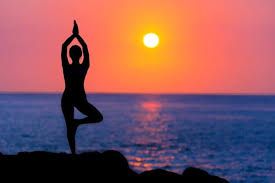Types Of Yoga Asana
May 29, 2019 • 13 views
Yoga is a group of physical, mental, and spiritual practices or disciplines which originated in ancient India. Yoga is one of the six orthodox schools of Hindu philosophical traditions. There is a broad variety of yoga schools, practices, and goals in Hinduism, Buddhism, and Jainism.
“Yogameans addition – addition of energy, strength and beauty to body, mind and soul.

Different types of asana..
Tadasana : In this asana the trunk is pulled upwards while in the standing position. The position of tadasana is like a tree.
Technique of Tadasana: Stand up, joint the heels and and toes of both the feet and lift the arms straight upward. Let the fingers of one hand cross those of the other hand. The wrists should be upward and the sight in front. Breathe in fully. Raise the heels and put the whole body weight on toes. Pull the body upwards. After sometime, breathe out and lower the body. Repeat this action 10-15 times.
Advantages :
It reduces obesity.
It raises the stature.
It removes constipated.
It prevents the disease of intestines.
2. Bhajangasana : In this asana, one lies down straight and loosens the trunk.
Technique : It is also know as sarapasana. In the asana, the position of the body is like that of a serpent. In order to perform this asana, lie down on the belly on the ground. Place both hands near the shoulders. Make a legs hard slowly and with the help of wrists raise the chest so much that the body gets completely straightened. Pull in the toes and hang the head slowly backwards. Return gradually to the former position. Repeat this asana 3-5 times.
Advantage :
Bhujangasana increases the digestive power.
It helps in getting rid of the diseases of liver and spleen.
It strengthens the muscles and vertebral column.
It strengthen lungs.
It removes constipation.
3. Paschimottanasana : In this asana, one holds the thumbs of the feet with the fingers and sits in such way that the trunk goes towars one side.
Technique: Spread both the legs forward sit on the ground. Hold their thumbs of the feet with both the hands. Breathe out slowly. Try to touch the knees. Breath in slowly raise. The head upwards, and return to the former position. This asana should be performed 10-15 times.
Advantage :
This asana provide strength ti the thighs.
It cleanses the blood vessels.
It reduces the excesive fat of the body.
It removes gas trouble.
4. Suryanamaskar : Has sixteen components but the sun having sixteen phases appears at the time of total annihilation of the universe. Normally, only twelve components of its are practised.
Technique :
Prayer or namaskar pose.
Arch back
Bend and touch knees
Push one leg back, hands inside legs touching ground.
Lip up, arms stretched, legs stretched or invert in V position.
Lower chest on the floor.
Arch chest with face upward.
Invert in V postion.
Lunge forward.
Forehead to kness.
Stretch back
Return to original pose and to restart.
Advantage:
It is the best yogic exercise.
It yield the benefits of asana, mudra and pranayama.
It prevents skin disease.
It removes constipation.
5. Shavasana : In this asana, one lies down prostrate and lossens the body. In order to perform this asana, lie down straight on the ground over the back and loosen all the part of the body completely. Gradually, breathe in deeply. The distance between the feet should be 1.5 feet.
Technique : Keep the wrist of the hands away from the body. Facing the sky. Close your eyes introspect and think as if the body is getting loose. Feel that the body is in a position of rest. This asana should performed for 3-5 min. It should be performed at the start and end of every asana.
Advantage :
It helps in getting rid of high blood pressure and mental tension.
It keeps the heart and brain fresh.
It removes the fatigue in the body.
